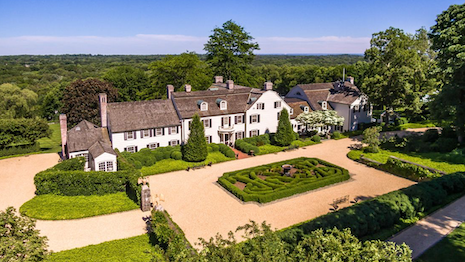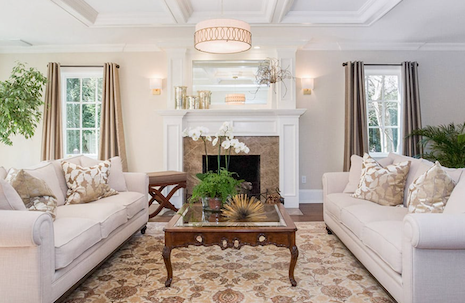 Single-family home in Greenwich, CT. Image credit: Houlihan Lawrence Real Estate
Single-family home in Greenwich, CT. Image credit: Houlihan Lawrence Real Estate
NEW YORK — The global pandemic has had a significant impact on the luxury real estate market in the United States, but experts remain positive and expect a new type of bedroom community to emerge.
Despite the pandemic, a combination of low inventory, surge of highly motivated buyers, low interest rates and a booming stock market has facilitated a steady increase in luxury real estate sales. During a session at the State of Luxury Real Estate eConference on Jan. 14, a panel of luxury real estate leaders discussed ways in which the health crisis has impacted lifestyle and housing preferences and what the implications of these changes are for the future.
“All indicators point to the real estate market having a good first half of 2021 and should stay strong throughout the year,” said Whitney LaCosta, owner broker of Coach Realtors, Northport, NY.
State of Luxury Real Estate was produced by Luxury Daily in association with Luxury Portfolio International
News ways of living
Since 2017, the luxury real estate markets in Westchester, NY and Greenwich, CT were seeing a steady decline, but then sales skyrocketed in the spring of 2020 as affluents began moving out of New York City when the virus started spreading, according to Liz Nunan, president and CEO of Houlihan Lawrence Real Estate.
“Low inventory and urgency to get out of populated cities contributed to the highly competitive environment,” Ms. Nunan said. “Homes in Greenwich selling for $3 million and above more than doubled in 2020, and nearly one in five luxury homes sold above asking price.”
In terms of where the high demand came from, Ms. LaCosta believes that the pandemic accelerated many millennial urban residents, who may have been planning to move out to the suburbs five years from now, to move out of the city now.
“When we talk about market time, the ultra high end listings of $8 to $10 million and above would typically sit on the market for 12 to 36 months,” Ms. LaCosta said. “Now, they only last six months to a year.”
 Coach Realtors is a member of Christie’s International Real Estate and Leading Real Estate Companies of the World. Image credit: Coach Realtors
Coach Realtors is a member of Christie’s International Real Estate and Leading Real Estate Companies of the World. Image credit: Coach Realtors
Despite many buyers complaining in recent years that existing inventory is outdated, there is now growing interest in traditional homes. John Turpin, broker owner of Turpin Realtors, suggested this is because the necessity of working and schooling from home has caused many buyers to rethink the value of closed floor plans.
“I don’t think the open floor plan is out of favor — it's aesthetically pleasing and functional — but people want privacy,” Mr. Turpin said. “The work-from-home model is a durable trend, so buyers are now open to investing in the more traditional homes.
“Additionally, the scarcity of new, updated homes has influenced buyers to pull the trigger on these more traditional homes they would have otherwise overlooked.”
Work commutes have often been a driving force in real estate desirability — the closer a home is to the train station, the higher the value is in the market. However, as working remotely becomes the new normal, exurbs may become the new bedroom communities.
“Markets further from train stations are seeing more sales because there is a weakening interest in being near the train,” Mr. LaCosta said. “I’ve seen a renewed interest in pied-à-terres in local towns — we’re seeing this sort of mini-urbanization going on in smaller towns.”
Further, many city residents who purchased homes in the country did not sell their apartments and condos in the city. In the event that remote work becomes a more permanent circumstance, there could be a rise in dual-primary residences.
“People have kept their apartments in Manhattan, but purchased a second home that has acted as a primary home for now,” Ms. Nunan said. “It begs the question: will they end up just splitting their time between the two residences?”
From a design standpoint, Lauren Fansler, editor at HGTV.com, shared a number of trends she is seeing in home design and renovation, which primarily reflect homeowners’ growing needs for amenities.
“Package drop-off rooms are becoming hugely popular, as new homeowners want a secure location for packages to be delivered at the house,” Ms. Fansler said. “Additionally, we’ve seen a lot of attention on mud rooms: a dedicated space to clean and sanitize things from outside before bringing them into the home.
 Contractors and designers are in such a high demand as affluents look to remodel homes. Image credit: HGTV.com
Contractors and designers are in such a high demand as affluents look to remodel homes. Image credit: HGTV.com
Due to the pandemic, the wellness trend has skyrocketed, as people shift their priorities to their own mental and physical health.
“People are now looking for organic clean products to fill their homes,” Ms. Fansler said. “Things like VOC-free paint, furniture without toxic materials and antibacterial and antimicrobial finishes.
“People now want kitchen zones: coffee zone, homework zone and butlers’ pantries,” she said. “As well as wine refrigerators and double of everything: islands, dishwashers, refrigerators and washing machines.”
Overall, the panelists anticipate these trends to continue through the first half of the year while the imbalance of low inventory and high demand will continue to lead to competition among buyers. They suggested that high-net-worth buyers will begin to branch outward from their cities and discover more “rural” properties.
Amenities for affluents
Homebuyers are seeking more cutting-edge amenities in luxury buildings and homes as they invest in home furnishings while marooned at home during the global pandemic.
According to panelists at the State of Luxury Real Estate eConference, must-have amenities include large areas to store cars and yachts and airports to store private planes.
Additionally, properties are being increasingly tailored to the needs of individuals and consultants are being recruited to ensure spaces meet different requirements. For instance, chefs check that kitchens have the proper appliances and personal trainers may help organize home gyms (see story).
While virtual assistants and artificial intelligence have been incorporated into home systems over the last few years, the technological evolution of luxury real estate has reached far beyond smart speakers. According to a separate panel of speakers at the State of Luxury Real Estate eConference, affluent homeowners are raising their expectations of technological integration in their homes.
Affluents seek systems that integrate harmoniously and do not require manual operation — the key is simplicity and automatization (see story).